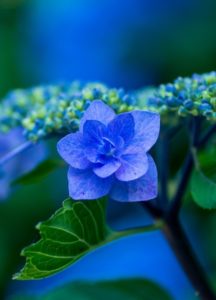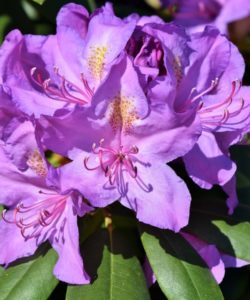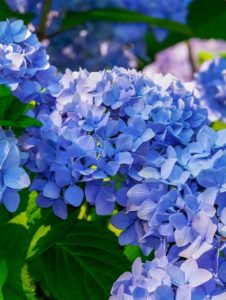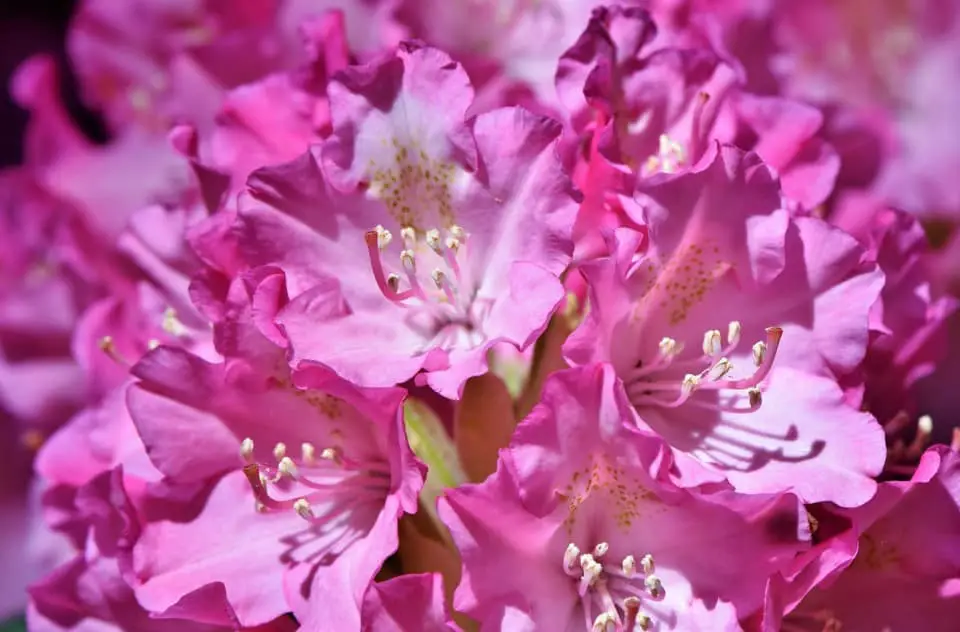Some links in the post are affiliate links and I get a commission from purchases made through some links found in the post.
If you are lucky enough to have either a hydrangea or a rhododendron in your garden then you will know that they are both wonderful plants.
Together, in a garden these two give a particular beauty and grace to any area they are planted in.
Hydrangeas are native to eastern areas of Asia and America while rhododendrons come from various regions such as the pacific northwest, Europe, Asia, and North America.
You will also fine them in the tropical areas of South-eastern Asia and the Himalayas.
Hydrangeas vs Rhododendrons – What are the Similarities?
Propagation
 Both hydrangeas and rhododendrons are easy to propagate by using the stem cutting method. You should aim to start propagating before the growing season.
Both hydrangeas and rhododendrons are easy to propagate by using the stem cutting method. You should aim to start propagating before the growing season.
Fall or early spring are good times as this will give the roots time to form before the flowering season starts.
Look for a sturdy stem with only 2-3 sets of leaves. Make a clean cut and remove the lower sets of leaves.
You may choose to use a rooting compound – cinnamon is a natural rooting compound. Now simply pot your cutting in new potting mix and keep the soil moist. You will see new growth in a few weeks.
Soil
Hydrangeas and rhododendrons are both sensitive to the pH of the soil they are planted in.
Both prefer acidic soils, so you need to ensure that the pH is between 5 – 5.5. Hydrangeas, being slightly less sensitive to this will tolerate a pH of slightly higher.
The flowers of the hydrangea will be more on the blue side if the soil is acidic. You will have pink blooms if the soil is more alkaline.
The rhododendron’s flowers are not affected by the pH of the soil, but they grow better in more acidic soil.
Neither plant enjoys soil which does not drain well. Hydrangeas may be more affected by boggy conditions than rhododendrons but neither plant will do well, and they may both develop root rot if the roots are always in soggy soil.
Fertilizer
Both hydrangeas and rhododendrons prefer soil which is enriched with good organic matter. Both plants need soil that retains moisture but does not leave them ‘boggy.
Hydrangeas will appreciate a dose of fertilizer early in spring. This will build up nutrients which have been used during the winter months.
Added to a layer of compost or mulch will greatly improve the quality of blooms in the next season.
Rhododendrons do not need to be fertilized if they look healthy and are growing well.
They will appreciate a dose of fertilizer to adjust the soil acidity in spring. Add to a 2” mulch around your plant and you will see a marked difference in the blooms.
We have an article on how to make a natural fertilizer for your hydrangea.
Height
Hydrangeas can grow up to 15’ in height. They are classed as fast growers and can spread to up to 10’ in good conditions.
Rhododendrons are also fast growers and can reach an enormous height if conditions suit it. You can easily find them growing to heights of up to 20 feet if they are in a happy place.
Sun and shade
While both plants prefer either full sun or partial shade, neither will do well in a completely shady spot. They will not grow well, neither will the flower in full shade.
If you are enjoying this article, check out our article on hydrangea tree vs bush.
Hydrangeas vs Rhododendrons – What are the Differences?
Hardiness
Hydrangeas do best in zones 9 and 10 while rhododendrons will also do well in zone 8.
While these are the most common of the two plants, there are in both species some varieties which can survive lower zones.
The Florida Pinxter will do well in zones 6-9 and the Pleasant White will grow in zones 5-8.
The French hydrangea will do just fine in zones 6-10 and the Oakleaf hydrangea will do well in zones 5-9.
Appearance
 Both hydrangeas and rhododendrons make amazing displays when they are in bloom.
Both hydrangeas and rhododendrons make amazing displays when they are in bloom.
Rhododendrons have their flowers dotted in among the leaves while the hydrangea seems to simply appear as a mass of fluffy blooms at the end of the stems.
The hydrangea bush in full bloom will appear as a mass of fluffy coloured blossoms, with hardly any leaves visible. The rhododendron will have blooms scattered throughout the leaves.
Hydrangea leaves tend to be less dark green than rhododendrons which can be a deep green.
Both grow fast and can reach huge heights and widths if the conditions are right for them.
Planting
Hydrangeas should be spaced 36”-60” apart to allow the plants to spread and not become crowded. The planting hole needs to be 2’ wider than the root ball.
Rhododendrons need to be planted up to 48” apart and at a depth of about 18”.
If draining is an issue, then both plants will benefit from being planted in a raised bed.
Watering Needs
Hydrangeas need about one inch of water per plant per week through the growing season. You should water them deeply to encourage the roots to grow.
Try to keep the water off the leaves as this may cause sun burn. On hot days it is better to water them in the mornings, which will stop them from wilting later in the day.
Rhododendrons need to be watered in the cool early mornings. They prefer just a trickle from the hose at the base of the plant. Although they need water, they do not need as much as hydrangeas.
Neither plant enjoys the soil around to be boggy so make sure that it drains well. If hydrangeas become bogged they may die from root rot.
For rhododendrons you can reduce the water to one inch every two weeks when the plant is mature, although in very dry times they will need to be watered more frequently.
For hydrangeas the best way to tell if they need water is to look at the leaves. If they are drooping, this is a clear sign that the plant needs to be watered.
Diseases and Pests
You will find that both plants rarely suffer from pests. You may occasionally find aphids and red spider mites on your hydrangeas. They may also suffer from root rot if the soil is boggy.
Rhododendrons that do not get enough water in the fall may look as if they are sun scalded during the winter. They will also show yellow leaves as a sign of iron deficiency or poor drainage.
Blooms
Hydrangeas bloom in the spring or towards the end of autumn. The flowers are easily recognised as large round globes or flowerheads. They appear fluffy and are at the end of stems.
Hydrangea blooms and stems are easily dried to add to dried flower arrangements.
Rhododendron flowers are bell shaped and have on average ten stamens each. The flowers are brightly coloured and bloom from late winter, through to early summer.
Although it is not advisable to ingest any part of a flower unless you absolutely know it is safe, it is interesting to know that Rhododendron flowers have long been used in Nepal for the healing properties for treating such things as headache, inflammation, and diarrhoea.
Flower Colours
Hydrangeas are well known for the diversity of colours in their blooms. Depending on the pH of the soil the flowers can range from pale yellow, and whites, to pinks, purples, violets, and blues. You will also see them in orange and red.
Hydrangea flowers are often used as cut flowers and added to flower arrangements. Indeed, with their variety of colours, they will be suitable for any colour scheme they are placed in.
Rhododendrons also have a wide range of colours, and you will find them blooming in anything from orange, orange/red, red, deep red, purple, yellow, cream, white and gold/white.
Can you Plant Rhododendrons and Hydrangeas Together?
While both hydrangeas and rhododendrons prefer acidic soul, they do differ in their sunlight needs.
Hydrangeas will do better if they receive morning sun and afternoon shade, with protection from winds, while rhododendrons do well in full sun and even partial shade, although they prefer to be placed in direct sunlight.
They will, however, grow in dappled sunlight although only for part of the day.
Neither plant will do well in complete shade, and neither enjoys soggy ground.
To help with hydrangea landscaping, check out our article here.
Final Thoughts
 Both hydrangeas and rhododendrons are magnificent plants and will grace and beautify any garden – as long as they are in suitable spots.
Both hydrangeas and rhododendrons are magnificent plants and will grace and beautify any garden – as long as they are in suitable spots.
Growing together they make a delightful pair, and even growing in separate areas they are certain to brighten up the area they grow in.
Because they are so easy to propagate you can always take a cutting of your favourite plant and add it to your garden.
Depending on where you want to plant them, they may be better planted apart due to the sun/partial shade needs. One thing is certain – neither plant enjoys being in complete shade so best to avoid areas where the sun never reaches.
Depending on your garden you may be able to grow them close by, but you can be sure that with a little forethought on placement and growing conditions, there is no reason why you cannot have several of these beautiful plants gracing your garden.
Before you go, here are some more related articles I encourage you to read below to help solve more of your gardening issues:
How to Make a Natural Fertilizer for Hydrangeas
How do you get Rid of Black Spots on Hydrangea Leaves
Why Are My Hydrangea Leaves Curling


